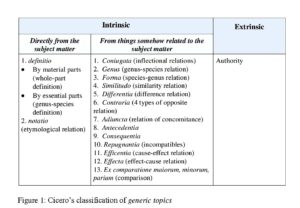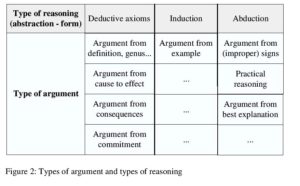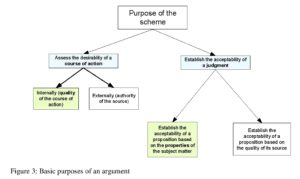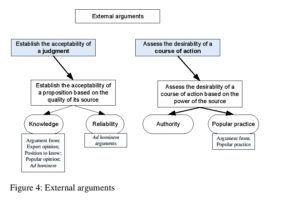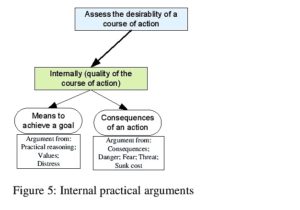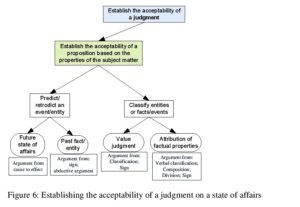ISSA Proceedings 2014 ~ A Means-End Classification Of Argumentation Schemes
No comments yetAbstract: One of the crucial problems of argumentation schemes as illustrated in (Walton, Reed & Macagno, 2008) is their practical use for the purpose of analyzing texts and producing arguments. For this purpose, argumentation schemes will be analyzed as prototypical combinations between two distinct levels of abstraction, i.e. semantic (or material) relations and types of reasoning. These two levels can justify an end-means criterion of classification, representing the intended purpose of an argument and the means to achieve it. This criterion is strictly bound to the pragmatic purpose of an argumentative move and the ontological (semantic) structure of the conclusion and the premises.
Keywords: abstraction, argument, argumentation schemes, classification, semantic relations, types of reasoning
1. Introduction
Argumentation schemes have been developed in argumentation theory as stereotypical patterns of inference, abstract structures representing the material (semantic) relation and logical relation between the premises and a conclusion in an argument. They can be regarded as the modern interpretation and reconsideration of the ancient maxims of inference (Walton, Reed & Macagno, 2008; Walton & Macagno, 2006). Many authors in the last fifty years have proposed different sets and classifications of schemes (see Hastings, 1963; Perelman & Olbrechts-Tyteca, 1969; Kienpointner, 1992a, 1992b; Walton, 1996; Grennan, 1997; Walton, Reed & Macagno, 2008; van Eemeren & Grootendorst, 2004). These approaches raise crucial problems concerning the criteria used for distinguishing and classifying the schemes, and defining the structure of an argumentation scheme. These apparently purely philosophical questions are becoming increasingly important for practical purposes, in particular the application of the schemes to the field of education (Macagno & Konstantinidou, 2013; Nussbaum, 2011; Duschl, 2008; Kim, Robert Anthony & Blades, 2012; Rapanta, Garcia-Mila, & Gilabert, 2013) and Artificial Intelligence (Mochales & Moens, 2009; 2011).
The purpose of this paper is to address the problem of classifying the schemes starting from the analysis of their nature and structure. The different components of the natural patterns of arguments will be distinguished, and in particular the quasi-logical and the semantic levels. These distinctions will be used to show the shortcomings of the existing classifications, and to propose a new model based on the pragmatic purpose of an argument, which is regarded as a move (speech act) in a dialogue.
1. Types of reasoning and semantic-ontological connections
The relationship between the premises and the conclusion of an argument can be reconstructed based on generic principles. What guarantees the inferential passage is a specific major premise that includes the predicates occurring in the minor premise and the conclusion. In order to reconstruct and motivate the inferential structure, we need to distinguish the specific principle of inference from two other different levels: 1) the general rules of inference, i.e. the generic, semantic-ontological connections between the predicates of the argument that establish the acceptability of an argument; and 2) the logical rules governing the formal disposition of the terms or propositions in an argument, i.e. the rules of commitment establishing the acceptance of an argument. These levels of abstraction will be referred to as “specific topoi,” “generic topoi,” and “rules of commitment” (or logical rules).
2.1 Specific topoi
In the Topics, Aristotle pointed out a crucial difference between the topoi (or rather generic topics) and the idia (the specific topics) (Rubinelli, 2009, pp. 59-70). According to Aristotle, the specific topoi represent propositions that relate to specific disciplines, such as ethics, law, or medicine, which are used to draw specific conclusions. For instance, in the third book of the Topics some specific principles of inference concerning the classification of “what is better” are set out (Topics, 116a 13-18). Specific topics can be used both as an instrument for invention, namely for generating and finding the premises of an argument, and as premises warranting the conclusion (De Pater, 1965, p. 134; Stump, 1989, p. 29). For instance, a specific topos concerning one of the possible ways of classifying an action as “better” than another can be directly used to support the conclusion. We can analyze the following case:
Saving the money for buying a house is more desirable than spending it on expensive cars, because a house is more lasting than a car.
 The reasoning can be represented as follows:
The reasoning can be represented as follows:
Minor premise – A house is more lasting than a car.
Major premise – That which is more lasting or secure is more desirable than that which is less so
Conclusion – A house is more desirable than a car.
The specific topos indicating one of the possible “operational” definitions of “to be better” directly warrants the conclusion. In specific domains of knowledge, specific topoi can be listed as instruments of invention, pre-packaged arguments that be used for supporting prototypical viewpoints. For example, ancient and modern treatises on legal topics (or rather on the specific commonly accepted principles of reasoning) indicate hundreds of topics that can be used by lawyers in certain circumstances, such as the following ones:
When a man and a woman refer to each other with the name of “spouse”, marriage is not proven, but is presumable. (Everardus, Loci Argumentorum legales, 54, 13th paragraph)
Where a person does an act, he is presumed in so doing to have intended that the natural and legal consequences of his act shall result. (Lawson, 1885, p. 262)
These propositions are used in law to support specific conclusions, i.e. prima facie cases that can be rebutted when additional information comes in. Such arguments, however, have the purpose of shifting the burden of production, leaving up to the other party to provide contrary evidence.
Specific topoi provide relations between specific concepts (“acts”), which are abstracted from their individual occurrences (this specific act). These specific rules of inference are the subject matter of a further process of abstraction, leading from concepts to categories of concepts or meta-concepts, the generic topoi.
2.2 Generic topoi – semantic-ontological relations
Generic topics can be considered as abstractions from the specific ones, or more correctly, an abstraction from a large number of specific topics. They provide classes of both necessary and defeasible inferences. In the first class fall some maxims setting out definitional properties of meta-semantic concepts, i.e. concepts representing semantic relations between concepts, such as definition, genus, and property. For example the locus from definition, which establishes the convertibility between definition and definiendum, represents also the essential logical characteristic that a predicate needs to have in order be considered as a “discourse signifying what a thing is.” Other loci, such as the ones based on analogy or the more and the less, are only defeasible, as they represent only usual commonly accepted relationships.
In the Topics, Aristotle focuses most of his analysis on the topics governing the meta-semantic relations between concepts, i.e. genus, property, definition, and accident. Cicero reduced the Aristotelian list of topoi to 20 loci or maxims, grouping them in generic categories (differences) and dividing them in two broad classes, the intrinsic and the extrinsic topics. While the first ones proceed directly from the subject matter at issue (for instance, its semantic properties), the external topics support the conclusion through contextual elements (for instance, the source of the speech act expressing the claim). In between there are the topics that concern the relationship between a predicate and the other predicates of a linguistic system (for instance, its relations with its contraries or alternatives). We can represent Cicero’s topics as follows:
This classification was the model that was taken into account by several dialectical theories, of which the most important, due to its influence on the further medieval accounts, is the one developed by Boethius in De Topicis Differentiis.
2.3 Rules of commitment – Logical form
The Latin and medieval dialectical tradition accounted for a type of loci that was not based on any semantic, metaphysical, or ontological relationship between concepts. These loci are not aimed at increasing the acceptability of a conclusion based on the acceptability of the content of its premises. Rather, they represent relations of acceptance (or commitment) between propositions. For instance, the acceptance of (or commitment to) the consequent of a conditional proposition follows from the acceptance of – or commitment to – the conditional and the antecedent thereof (Cicero, Topica, 53, 1-25). These “formal” topics were analyzed in particular in the dialectical theories of the 12th and 13th century. Such theories conceived the categorical syllogisms as proceeding from topics from the whole to the part, called “dici de omni” and “dici de nullo.” These topics were grounded not on the semantic-ontological content of the propositions, but only on the meaning of the quantifiers (Green-Pedersen, 1984, p. 256).
This distinction between semantic-ontological and formal (logical) topics suggests an analysis of the different rules of inference in which the semantic-ontological topics are combined with the logical rules. Formal topics can be thought of as representing the highest level of abstraction, which groups together more generic principles different and somehow similar argument structures (Searle, 2001, p. 19). For example, the ancient topics from antecedents or “dici de omni” formalize the deductive pattern of modus ponens normally used in dialectics. However, many acceptable and reasonable arguments, such as reasoning from example or sign, follow formal patterns different from the deductive ones (see also Blair, 2007; Godden, 2005). In addition to the deductive rules, also the inductive ones need to be accounted for, and the type of reasoning called “abduction” (Pierce, 1992, pp. 140-141), “retroduction” (see Greenland, 1998, p. 545; Poole, 1988) or reasoning from best explanation (Josephson & Josephson, 1996, p. 15).
The prototypical relationship between the types of argument and the logical level of abstraction can be summarized in the table below, where three most important types of reasoning (or categories of arguments of the highest level) are distinguished:
This classification suggests the possibility of analyzing arguments from a multi-logical perspective, in which the logical form can be described using distinct types of reasoning, which in turn can include various logical rules of inference (MP, MT…). However, in the Latin and medieval tradition, the formal rules of inference are treated as maxims and not as distinct levels of abstraction. For this reason, the two levels of the general, semantic topics and of the logical rules are not distinguished, and the possible interconnections between them are not taken into account.
The modern theories of argument schemes or argumentation schemes inherited this model, proposing classifications essentially mirroring the ancient approach. The rules of commitment are treated at the same level as the semantic-ontological topics, and not as distinct levels of abstraction. This approach can be extremely helpful for quickly identifying common characteristics in the arguments that are frequently used, but it leads to classificatory problems. A possible solution is to acknowledge the discrepancy between logical form and semantic content as a divergence in kind, and try to show how these two levels can be interconnected. The starting point is the model that, by merging the two levels, best mirrors the multi-logical approach to natural arguments: the model of argumentation schemes (Walton, Reed & Macagno, 2008).
2. Argumentation schemes as imperfect bridges
Argumentation schemes are stereotypical patterns of inference, combining semantic-ontological relations with types of reasoning and logical axioms and representing the abstract structure of the most common types of natural arguments. The argumentation schemes provided in (Walton, Reed & Macagno, 2008) describe tentatively the patterns of the most typical arguments. However, by failing to distinguish between the two levels of abstraction, under the label of “argumentation schemes” fall indistinctly patterns of reasoning such as the abductive, analogical, or inductive ones, and types of argument such as the ones from classification or cause to effect.
In order to design a system for classifying the schemes, it is useful to understand the limits thereof, and investigate how the two distinct levels of abstraction are merged. For example the argument from cause to effect will be taken into account (Walton, Reed & Macagno, 2008, p. 168):
 This argumentation scheme is based on a defeasible modus ponens, which is combined with a semantic causal relation between two events. The semantic-ontological level is merged with the logical one, and this combination represents only one of the possible types of inferences that can be drawn from the same semantic-ontological connection. The actual relationship between the two levels of abstraction is much more complex. For example, we consider the classic Aristotelian causal link between “having fever” and “breathing fast,” and see how this cause-effect relation can be used to draw a conclusion on the basis of different logical rules:
This argumentation scheme is based on a defeasible modus ponens, which is combined with a semantic causal relation between two events. The semantic-ontological level is merged with the logical one, and this combination represents only one of the possible types of inferences that can be drawn from the same semantic-ontological connection. The actual relationship between the two levels of abstraction is much more complex. For example, we consider the classic Aristotelian causal link between “having fever” and “breathing fast,” and see how this cause-effect relation can be used to draw a conclusion on the basis of different logical rules:
1. He had fever. (Fever causes breathing fast). Therefore, he (must have) breathed fast.
2. He did not breathe fast. (Fever causes breathing fast). Therefore, he had no fever.
3. He is breathing fast. (Fever causes breathing fast). Therefore, he might have fever.
4. He is has no fever. (Fever causes breathing fast). Therefore, he may be not breathing fast.
5. You may have fever. When I had fever, I was breathing fast, and you are breathing fast.
These cases illustrate how different logical rules can be followed to draw a conclusion from the same semantic connection, in this case a causal relation. Cases (1) and (2) represent instantiations of defeasible axioms, i.e. the defeasible modus ponens (in 1), and the defeasible modus tollens (in 2). Cases 3 and 4 proceed from abductive reasoning. In (3) the conclusion is drawn by affirming the consequent, while in (4) the denial of the antecedent can be rephrased by contraposition as “not breathing fast is caused by having no fever,” leading to a conclusion drawn abductively (Walton, Reed & Macagno, 2008: 173). Finally, in (5) the conclusion is based on an inductive generalization, based on a single case. The prototypical nature of the relationship between semantic relations and logical rules (types of reasoning and axioms) hides, in this sense, the lack of correspondence between these two levels. For this reason, a classification system of the argumentation schemes based on these criteria would be inaccurate. Different criteria are needed, accounting for this twofold nature of the schemes.
3. A means-end classification
Argumentation schemes can be conceived as the combination of semantic (or topical) relations with logical rules of inference. A classification based on the semantic link can provide an instrument for bringing to light the material relation between premises and conclusion. However, the same semantic relation can be combined with various logical rules, and lead to various types of conclusion. For example, causal relations are the ground of the argument from cause to effect, but also or arguments from sign and practical reasoning. A classification based only on the semantic content would blur these fundamental differences. For this reason, it is necessary to find an overarching classificatory principle.
Argumentation schemes can be thought of as instruments for reconstructing and building arguments (intended as discourse moves), i.e. analytical or invention tools. For this reason, in order to provide a classificatory system to retrieve and detect the needed scheme it can be useful to start from the intended purpose of an argumentation scheme. From an analytical point of view, the analysis of an argument in a discourse, a text, or dialogue presupposes a previous understanding of the communicative goal (and, therefore, the “pragmatic” meaning) of the argument and the components thereof. For example, an argument can be aimed at classifying a state of affairs, supporting the existence of a state of affairs, or influencing a decision-making process.
This teleological classification needs to be combined with a practical one, as the generic purposes of a move need to be achieved by means of an inferential passage. In this sense, the classificatory system needs to account for the possible means to achieve the pragmatic purpose of an argument. Not all the semantic (material) relations that are at the basis of the schemes can support all the possible conclusions or purposes of an argument. Definitional schemes are aimed at supporting the classification of a state of affairs, and are unlikely to lead to the prediction or retrodiction of an event. Similarly, a pattern of reasoning based on the evaluation of the consequences of an action or an event can be used to establish the desirability of a course of action brining it about, but cannot reasonably lead to the truth or falsity (or acceptability) of a proposition. For this reason, the analysis of the pragmatic meaning (i.e. the purpose) of an argument provides a criterion for restricting the paradigm of the possible means to achieve it. The crucial problem is to find categories of argument purposes that can establish criteria for distinguishing among classes of semantic relations, which in turn can be specified further according to the means to achieve such goals.
The first distinction to be made is based on the nature of the subject matter, which can be a course of action or a state of affairs. In the first case, the goal is to support the desirability or non-desirability of an action, while in the second one the schemes are aimed at providing grounds for the acceptability of a judgment on a state of affairs. The ancient dialectical accounts (see Cicero, Topica and Boethius, De Topicis Differentiis) distinguished between two types of argumentative “means” to bear out a conclusion, i.e. the “internal” and the “external” arguments. The first ones are based on the characteristics of the subject matter (such as arguments from definition or cause), while the others derive their force from the source of the statement, i.e. from the authority of who advances the judgment or the proposal (arguments from authority). This first distinction can be represented as follows:
The acceptability of a conclusion can be supported externally in two ways. If the argument is aimed at establishing the desirability of a course of action, the authority can correspond to the role of the source needed for recommending or imposing a choice (“You should do it because he told you that!”). Otherwise, the popular practice can be a reason for pursuing a course of action (“We should buy a bigger car. Everyone drives big cars here!”). When external arguments are used to support also a judgment on a state of affairs, the relevant quality of the source is not the speaker’s authority (which is connected with the consequences of not complying with the orders/conforming to common behavior) but rather with his superior knowledge. The quality of the source can be also used negatively to show that a source is not reliable (it is not a good source), and that consequently the conclusion itself should be considered as doubtful (ad hominem arguments). The external arguments can be represented as follows:
Internal arguments need to be divided into the two categories of arguments aimed at assessing the desirability of a course of action, and the ones supporting the acceptability of a judgment. Courses of action can be classified as desirable or not depending on the quality of their consequences (the course of action is a condition of a resulting positive or negative state of affairs) or their function in bringing about a desired goal (an action is productive of a pursued state of affairs):
The arguments used to provide grounds for a judgment on a state of affairs can be divided according to the nature of the predicate that is to be attributed. The most basic differentiation can be traced between the predicates that attribute the existence of a state of affairs (the occurrence of an event or the existence of an entity in the present, the past, or the future), and the ones representing factual or evaluative properties. The arguments supporting a prediction or a retrodiction are aimed at establishing whether or not an event has occurred or will occur, or whether an entity was or will be present (existent). The arguments proceeding from casual relations (in particular from material and efficient causes) bear out this type of conclusion. The other type of predicates can be divided in two categories: factual judgments and value judgments. The first type of predicates can be attributed by means of reasoning from classification, grounded on descriptive (definitional) features and supporting the attribution of a categorization to an entity or an event (Bob is a man; Tom is a cat). Value judgments are classifications that are not based on definitions of categorical concepts (to be a cat) but rather on values, or rather hierarchies of values. Such judgments proceed from criteria for classifying what is commonly considered to be “good” or “bad.” Also the reasoning underlying the attribution of evaluative predicates, such as “to be a criminal,” can be considered as belonging to this group of arguments. These latter patterns are grounded on signs of an internal disposition of character, which in its turn is evaluated. The distinctions discussed above are summarized in figure 6 below.
This system of classification of argumentation schemes is based on the interplay between two criteria, the (pragmatic) purpose of an argument and the means to achieve it. This dichotomic model can be used both for analytical and production purposes. In the first case, the speaker’s intention is reconstructed by examining the generic purpose of his move, and then the possible choices that he made to support it, based on the linguistic elements of the text (Macagno & Zavatta, 2014; Macagno & Walton, 2014, Ch. 5; Macagno & Damele, 2013). Depending on the desired level of preciseness, the analysis can be narrowed down until detecting the specific scheme, i.e. the precise combination of the semantic principle and the logical rule supporting the conclusion. In this fashion, the analyst can decide where to stop his reconstruction. This analytical model can be of help also for educational purposes, as it can be adapted to various teaching needs and levels (detecting arguments in a text; reconstructing implicit premises, etc.). For production purposes, the nature of the viewpoint to be argued for opens up specific alternative strategies to support it, which in turn can be determined by the characteristics of the conclusion.
This model relies on the analyst’s or the speaker’s reconstruction or awareness of the purpose of a move, which can be partially identified by taking into consideration the nature of the subject matter (whether it is a decision or a judgment). The purpose then opens up possible choices according to the generic goal of the communicative act. The speaker’s intention can be further specified by detecting the most generic strategy chosen to provide a basis for the acceptability of the conclusion. In this case, in order to reconstruct the move or provide an argument, the analyst or the speaker can choose whether to use some properties of the subject matter or to appeal to an external source. In the first case, the means used to achieve the goal are determined by the nature of the subject matter. In particular, the crucial distinction is between the classification and the prediction or retrodiction of an entity or state of affairs. This choice leads to a further specification of the nature of the viewpoint that the speaker intends to support with his argument (is the event a future or a past one? is the classification a value judgment or does it consist in the attribution of factual properties?), and then to the specific means that can be used to achieve this precise purpose (argument from values, from definition, etc.). In case of decision-making, the argumentation schemes are classified according to the same interrelation between goal and generic strategies. The internal arguments can be divided between reasoning from consequence and reasoning from means to goal.
An alternative to the internal, more complex arguments, is provided by external arguments, where the choice of backing the conclusion by means of the opinion of a knowledgeable and reliable source can be further made more specific by distinguishing between the kinds of sources (experts or the majority of people) and the nature of the support (knowledge or reliability).
The semantic relation characterizing a scheme can be “shaped” according to different types of reasoning, i.e. logical forms. For instance, the desirability of a course of action can be assessed internally by taking into consideration the means to achieve a goal. However, this pattern of reasoning can be stronger or weaker depending on whether there is only one or several alternatives. The paradigm of the possible means will determine whether the reasoning is abductive or deductive, resulting in a conclusion more or less defeasible. The same principle applies to the other semantic relations, such as the ones proceeding from cause or classification, which can be shaped logically according to inductive (or analogical), deductive, or abductive types of reasoning.
3. Conclusion
The classification of argumentation schemes is a problem from which their development and application depends. Given their number and complexity, their use becomes problematic without a system guiding their selection. In order to organize the schemes in a useful and accessible way, it is crucial to understand their nature and their components. Argumentation schemes are the result of a combination of two levels of abstraction: semantic (or topical) relations, and logical forms. Semantic relations provide a criterion of classifying the arguments based on the content of their major premise, and represent what makes a conclusion more acceptable than the premises. The logical forms (the types of reasoning and rules of inference) instantiate the rules of acceptance, i.e. how a premise supports a conclusion based on the relation between the antecedent and consequent, or between the quantification of the predicates in the premises and the conclusion. The possible combinations between them are extremely complex. Argumentation schemes are imperfect bridges between these two levels. They are the most frequent and common combinations that characterize the fundamental arguments used in everyday argumentation. They are incomplete abstractions, simplified and prototypical patterns that cannot be organized according to the aforesaid semantic and logical levels.
In order to classify the schemes, it is necessary to find a criterion of classification transcending both levels of abstraction, and leading to a dichotomic system, which can be used proceeding both from the affirmation of a disjunct, and from exclusion of the alternative. The classificatory system proposed in this paper is not based on what an argument is, but rather on how it is understood and interpreted, i.e. on its communicative purpose. In this fashion, a classification system can mirror the actual practices of reconstructing and using arguments. The purpose of an argument is connected with the means to achieve it, which are determined by the ontological structure of its conclusion and its premises. On this view, it is possible to suggest a course of action, to predict an event, or to classify an entity, depending on the nature of the predicate(s) attributed in the premises that support or can be used to support the conclusion. The system of classification becomes a tree of dichotomic choices aimed at reconstructing or achieving a communicative goal.
References
Aristotle (1984). Topics. Translated by W. A. Pickard-Cambridge. In J. Barnes (Ed.), The Works of Aristotle. Princeton: Princeton University Press.
Blair, J. A. (2007). The “logic” informal logic. In H.V. Hansen, et. al. (Eds.), Dissensus and the Search for Common Ground CD-ROM (pp. 1-16). Windsor, ON: OSSA.
Boethius, S. (1978). De Topicis Differentiis (edited with a translation, introduction and commentary by E, Stump). Ithaca, NY: Cornell University Press.
Cicero, M. T. (2003). Topica (edited with a translation, introduction and commentary by T. Reinhardt). Oxford: Oxford University Press.
De Pater, W. (1965). Les Topiques d’Aristote et la Dialectique Platonicienne. Fribourg, Germany : Éditions de St. Paul.
Duschl, R. (2008). Science Education in Three-part Harmony: Balancing Conceptual, Epistemic, and Social Learning Goals. Review of Research in Education, 32, 268-291.
Eemeren, F. van, & Grootendorst, R. (2004). A systematic theory of argumentation: The pragma dialectical approach. Cambridge: Cambridge University Press.
Everardus, N. (1607). Loci Argumentorum legales. Venetiis: apud Matthaeum Valentinum.
Godden, D. (2005). Deductivism as an interpretive strategy: A reply to Groarke’s defense of reconstructive deductivism. Argumentation and Advocacy, 41(3), 168-183.
Greenland, S. (1998). Probability logic and probabilistic induction. Epidemiology, 9, 322–332.
Green-Pedersen, N. J. (1984). The Tradition of Topics in the Middle Age. Munich, Germany: Philosophia Verlag.
Grennan, W. (1997). Informal Logic. Montreal, Quebec: McGill-Queen’s University Press.
Hastings, A. (1963). A Reformulation of the Modes of Reasoning in Argumentation. Evanston, Illinois: Ph.D. Dissertation, Northwestern University.
Josephson, J., & Josephson, S. (1996). Abductive Inference. Computation, Philosophy, Technology. New York: Cambridge University Press.
Kienpointner, M. (1992a). Alltagslogik: Struktur und Funktion von Argumentationsmustern. Stuttgart, Germany: Fromman-Holzboog.
Kienpointner, M. (1992b). How to Classify Arguments. In F.H. van Eemeren, R Grootendorst, J.A. Blair & C.A. Willard (Eds.) Argumentation Illuminated (pp. 178-188). Amsterdam: Amsterdam University Press.
Kim, M., Anthony, R., & Blades, D. (2012). Argumentation as a Tool to Understand Complexity of Knowledge Integration. In Proceedings of the 2nd International STEM in Education Conference – Beijing, China – 24-27 November 2012 (pp. 154-160). Beijing: Beijing Normal University.
Lawson, J. (1885). The Law of Presumptive Evidence. San Francisco: Bancroft & Co.
Macagno, F., & Damele, G. (2013). The Dialogical Force of Implicit Premises: Presumptions in Enthymemes. Informal Logic, 33, 365-393.
Macagno, F., & Konstantinidou. A. (2013). What Students’ Arguments Can Tell Us: Using Argumentation Schemes in Science Education. Argumentation, 27, 225-243.
Macagno, F., & Walton, D. (2014). Emotive language in argumentation. New York: Cambridge University Press.
Macagno, F., & Zavatta, B. (2014). Reconstructing metaphorical meaning. Argumentation, 28, 453-488.
Mochales, R., & Moens, M.F. (2011). Argumentation Mining. Artificial Intelligence and Law, 19, 1-22.
Mochales, R., & Moens, M.F. (2009). Argumentation Mining: The Detection, Classification and Structuring of Arguments in Text. In Proceedings of the Twelfth International Conference on Artificial Intelligence and Law (ICAIL), June 8-12. Universitat Autonoma de Barcelona, Barcelona (pp. 98-107). New York: ACM.
Nussbaum, M. (2011) Argumentation, Dialogue theory and Probability Modeling: An Alternative Framework for Argumentation Research in Education. Educational Psychology, 46, 84-106.
Peirce, C. S. (1992). Reasoning and the logic of things: The Cambridge Conferences Lectures of 1898. Edited by K.L. Ketner. Cambridge, MA: Harvard University Press.
Perelman, C., & Olbrechts-Tyteca, L. (1969). The New Rhetoric: A Treatise on Argumentation. Translated by Wilkinson, J. & Weaver, P. Notre Dame, Ind.: University of Notre Dame Press.
Poole, C. (1988). Induction does not exist in epidemiology, either. In Rothman KJ (Ed.), Causal inference (pp. 153-161). Chestnut Hill, MA: E.R.I.
Rapanta, C., Garcia-Mila, M., & Gilabert, S. (2013). What Is Meant by Argumentative Competence? An Integrative Review of Methods of Analysis and Assessment in Education. Review of Educational Research, 83, 483-520.
Rubinelli, S. (2009). Ars Topica. The classical technique of constructing arguments. Dordrecht: Springer.
Searle, J. (2001). Rationality in Action. Cambridge, MA: MIT Press.
Stump, E. (1989). Dialectic and its Place in the Development of Medieval Logic. Ithaca: Cornell University Press.
Walton, D. (1996). Argumentation Schemes for Presumptive Reasoning. Mahwah: Lawrence Erlbaum Publishers.
Walton, D., & Macagno, F. (2006). Argumentative reasoning patterns. In Proceedings of 6th CMNA (Computational Models of Natural Argument) Workshop, ECAI (European Conference on Artificial Intelligence), Riva del Garda, Italy, August 28 – September 1 ( pp. 48-51). Trento: University of Trento Italy.
You May Also Like
Comments
Leave a Reply
